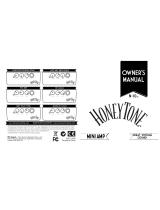
PAGE 8
FRONT PANEL: Controls & Features (Continued)
As in most tube guitar amplifiers, the TREBLE Control (in both channels of your ACE ) is the most powerful of the
rotary controls and is next in line only to the GAIN Control as a shaping tool. Because it is first in the signal path of the tone controls
- and from here the Middle and Bass receive their signal - it is by far the dominant tone control. For this reason the setting of the
TREBLE Control is very important for equal representation of the three frequency regions to appear at their respective controls. Like
most of the controls on your
ACE, there is an optimum region of the TREBLE
Control where ample top end is mixed in and yet enough signal is still passed on to
the MIDDLE and BASS Controls.
As you might surmise, here is the sweet spot. There are definitely great sounds
above and below this middle region (11:00 - 1:30), but the balance between the
TREBLE Control and the other two tone controls is compromised.
The one place you may want to throw caution to the wind and set the TREBLE Control
above this median zone presents itself in Channel 1. In CRUNCH, the
TREBLE Control can be used to dump extra gain into the mix.
This is especially effective for crunch sounds. When doing so, use the PRESENCE Control to roll off some of the more than ample
top end for a more compressed feel and fatter voice. As you might surmise, the BASS Controls’ effectiveness will be reduced, so you
may have to run a much higher setting than you are used to seeing to achieve a balance. This said, keep in mind that the
TREBLE
Control in Channel 1 CRUNCH should not be set much above 2:30 to avoid unwanted microphonic tube problems.
The MID Control is responsible for the blend of midrange frequencies in the mix and though its effect is not as dramatic as
that of the TREBLE Control, it plays an integral part in achieving any sound in your
ACE. It is capable of changing the feel dramati-
cally as it blends in a group of frequencies that tend to soften or stiffen the way a sound feels to play.
Many players tend to lean in the direction of lower
MIDDLE Control settings (7:00 - 11:00) where a
scoop in this region produces girth (by letting the Bass become a little more dominant) and a lack of
punch lends a more compressed, even feel to the strings and therefore less apparent resistance to
the pick. As the
MIDDLE Control is increased, (11:30 - 1:30) the sound is rounded-out and filled-in
with a focused mid attack appearing rather quickly. As you would guess, the feel starts to change
- becoming more resistant. Above this region the MIDDLE Control could be used to compensate for
either weaker pick-ups or for times when a specific deficiency is produced by either an extremely
high setting of other tone controls, or a physical anomaly in the room. While these
MIDDLE Control
settings (2:00 - 5:00) can introduce added gain and create enhanced focus, the trade-off will be a
stiffer, more forward, less compressed feel.
Last, but not least in the string of tone controls we come to the BASS . This control works similarly in both channels in
that it determines the amount of low frequencies present in a sound. However, the actual frequencies and style of lows it mixes in
changes from channel to channel and within the different modes. Like the MIDDLE Control, it falls in line signal-wise
after the TREBLE
Control and the same scheme applies. When the TREBLE Control is set high, the effectiveness of the BASS and MIDDLE Controls
is reduced. If the TREBLE Control is set low these two controls become dominant.
For the most balanced sound and a balance of power between the three rotary tone controls, try to
use the TREBLE Control in its middle ranges. This scenario produces nearly equal representation
of all the frequencies on the tone controls and provides a great neutral starting point for further
tweaking.
GAINTREBLE
INPUT
FT.SW
FAT
CLEAN
CRUNCH
FLUID
DRIVE
CRUNCH
T
I
T
E
T
I
T
E
C
L
N
G
A
I
N























